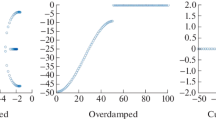Abstract
One presents some algorithms related among themselves for solving the partial and the complete eigenvalue problem for an arbitrary matrix. Algorithm 1 allows us to construct the invariant subspaces and to obtain with their aid a matrix whose eigenvalues coincide with the eigenvalues of the initial matrix and belong to a given semiplane. Algorithm 2 solves the same problem for a given strip. The algorithms 3 and 4 reduces the complete eigenvalue problem of an arbitrary matrix to some problem for a quasitriangular matrix whose diagonal blocks have eigenvalues with identical real parts. Algorithm 4 finds also the unitary matrix which realizes this transformation. One gives Algol programs which realize the algorithms 1–3 for real matrices and testing examples.
Similar content being viewed by others
Literature cited
A. N. Beavers and E. D. Denman, “A computational method for eigenvalues and eigenvectors of a matrix with real eigenvalues,” Numer. Math.,21, No. 5, 389–396 (1973).
A. N. Beavers and E. D. Denman, “A new similarity transformation method for eigenvalues and eigenvectors,” Math. Biosci.,21, 143–169 (1974).
J. D. Roberts, “Linear model reduction and solutions of algebraic Riccati equations by use of the sign function CUED/B-Control/TR 13,” Rpt. Cambridge University (1971).
D. K. Faddeev, V. N. Kublanovskaya and V. N. Faddeeva, “Linear algebraic systems with rectangular matrices,” in: Modern Numerical Methods, No. 1 (Proc. Int. Summer School on Numerical Methods, Kiev, 1966), Moscow (1968), pp. 16–75.
V. N. Kublanovskaya, “The Newton method for the determination of the eigenvalues and the eigenvectors of matrices,” Zh. Vychisl. Mat. Mat. Fiz.,12, No. 6, 1371–1380 (1972).
P. A. Businger and G. H. Golub, “Linear least squares solutions by Householder transformations,” Numer. Math.,7, No. 3, 269–276 (1965).
T. Ya. Kon'kova, “Algol procedures for solving certain problems of algebra, based on the application of a normalized process,” Zap. Nauchn. Sem. Leningr. Otd. Mat. Inst.,35, 36–44 (1973).
R. S. Martin, G. Peters, and J. H. Wilkinson, “The QR algorithm for real Hessenberg matrices,” Numer. Math.,14, No. 3, 219–231 (1970).
P. J. Eberlein, “Solution to the complex eigenproblem by a norm reducing Jacobi type method,” Numer. Math.,14, No. 3, 232–245 (1970).
H. Rutishauser, “Simultaneous iteration method for symmetric matrices,” Numer. Math.,16, No. 3, 205–223 (1970).
R. S. Martin and J. H. Wilkinson, “Reduction of the symmetric eigenproblem Ax=ΛBx and related problems to standard form,” Numer. Math.,11, No. 2, 99–110 (1968).
Additional information
Translated from Zapiski Nauchnykh Seminarov Leningradskogo Otdeleniya Matematicheskogo Instituta im. V. A. Steklova AN SSSR, Vol. 70, pp. 124–139, 1977.
Rights and permissions
About this article
Cite this article
Kublanovskaya, V.N., Savinova, L.T. Solving the eigenvalue problem for matrices. J Math Sci 23, 1966–1978 (1983). https://doi.org/10.1007/BF01093278
Issue Date:
DOI: https://doi.org/10.1007/BF01093278




